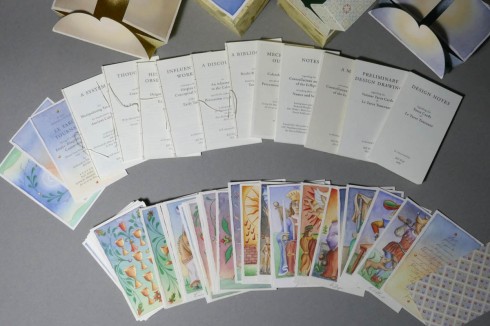Inside the Box
My previous entry, “Meanwhile, a couple of years later…” pointed out the artist’s struggle to balance notions of complexity with real-world practicality. So now I will elaborate on that idea, with an example —
It seems that translating the Big Idea into something you can hold in your hand, like a tarot deck, is harder than it sounds. It involves spending a lot of time and effort working out details that end up being virtually invisible to casual observation.
The Artist’s Book that I’ve shown on the site, Le Tarot Tournant: Hypotyposis Systematis Mundam, is pretty much the purest expression of this Big Idea that I’m capable of producing. Having invested an inordinate amount of time in its conception, virtually nothing about it remains arbitrary or left to chance. For example, I thought about ideas for the box design for a couple of years before I actually devised a workable prototype. Rather than creating a simple, functional container for a deck of cards, I looked at the potential opportunity to make the packaging function as a transformative entry point into the project.
Recognizing the idea of looking at the work as a “Viewing Process”, rather than simply a presentation of a collection of singular images, enabled me to deliberately orchestrate a transition from “outer appearance” to “an inner vision.” A complex box ensures that the imagination is fired up so that the inner eye sees the immaterial metaphysical world as if it is happening in the here & now, (Or perhaps more accurately, the Then and There,) whether or not anyone actually notices the effect as it happens.

The initial impression is quite a simple one: The user is confronted with a relatively unassuming box, covered in some variety of mulberry paper that has randomly interspersed natural inclusions and bits of leaves and bark scattered throughout its surface. It is a deliberately natural surface, and it is deliberately chosen as a random, non-geometric, irregular pattern. A label on the top is painted to look like a window into a blue sky, and offers a kind of entry point that is transitional from the rational to the metaphysical world within. A “pole star” at the center of the label establishes a central axis that runs through the box. The act of reading the title establishes a revolving motion around that axis, and sets forth the basis of the work. Four small colored balls define the seasons at the four points of a year, further reinforcing the foundation of the overall work.

The box lid is in the form of a perfect cube, with another label inside, the design of which re-emphasizes the central rotational axis point. But reading another inscription from this side sets the rotation in the opposite direction, and establishes the motion of precession. (A complex, but important idea at the core of the work.) Once the top-cube is removed, the exposed inner portion of the box is blanketed with a carefully composed geometric repeat pattern, in shades of green, that again echoes the four points of the year. This composition signals a change in viewpoint from randomness to methodically structured order. Two halves of the upper portion of the box swing open to reveal the contents: A pair of inner folder-boxes.

The whole is structured like the two halves of the brain: The right side folder contains the visual imagery in card form, the left side folder contains the written intellectual portion of the work. Two perspectives on the same idea are presented. The two halves, in their two folder-boxes, come together within the outer shell to form a complete entity.
The two folder-boxes are painted on all sides with a “glow” design. In each case, the light source of the glow is located on the central axis, at the center point of the outer box. If we imagine our eye at that point, (the source of the light,) as if we were standing inside the work while the two folder-boxes are housed there, we may look out in all directions at the interior walls of the outer box and see a landscape of undulating hills with ground below and a sky above. In one direction, we see a shining sun above green grass. (Summer.) Opposite, we see a darker sky and faded grass. (Winter.) There is another circular inscription on the grassy floor. Reading it continues the rotational motion that was established on the initial outer label.

When the folder-boxes are removed from the outer box and opened to reveal their contents, their structured form collapses, and they fall into a mass of disorganized panels that are left behind. At this point in the Process of Looking, ordered control has been transferred over to the reader.

We are now inside the box.

The next entry looks at the old question:
If a tree falls in the woods, is it worth it…?

Beautiful!
If a deck is left unpublished, is it worth it?
LikeLike
I’m not sure. What about a work of art,: and an historical scientific and metaphysical instrument?
LikeLike
This blows my mind! So cool!!
LikeLiked by 1 person